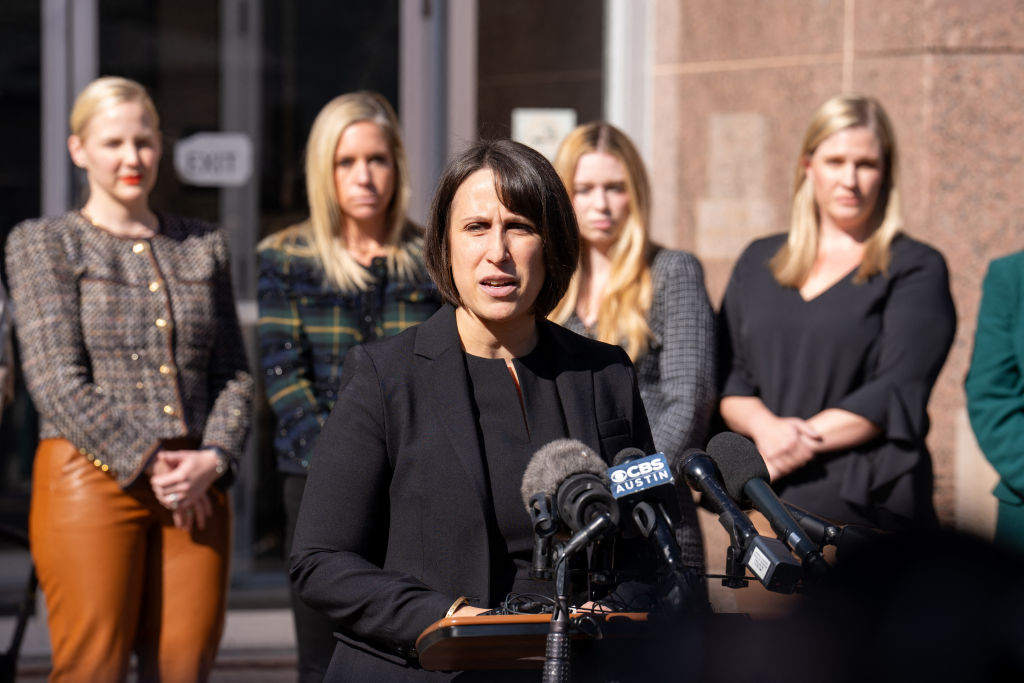For the first time since the 2022 Dobbs decision, a pregnant woman asked for court pre-authorization of an abortion, and the story out of Texas has drawn national headlines—as well as misleading claims by politicians and activists about its underlying facts.
Kate Cox, a 31-year-old woman from Dallas, decided to seek an abortion after a prenatal test known as an amniocentesis confirmed on November 28 that her baby had trisomy 18, a chromosomal abnormality that usually results in the death of the child during pregnancy or within the first year of birth.
“Of those pregnancies surviving into the third trimester, nearly 40% of babies diagnosed with Edwards syndrome (trisomy 18) don’t survive during labor,” according to the Cleveland Clinic. Among those who are born alive, “no more than 10% survive past their first year.”
It’s a tragic, but not always fatal, diagnosis: Bella Santorum, the daughter of the former U.S. senator and presidential candidate Rick Santorum, was born with trisomy 18 and is now 15 years old. “Not only do some of these children survive, they survive with a pretty good quality of life,” Dr. Robert Marion, director of the Center for Congenital Disorders at the Children's Hospital at Montefiore Medical Center, told ABC News in 2012. “In children who are doing reasonably well, we will perform surgical procedures or provide more aggressive feeding therapy in order to give the kids a chance to make it.”
How does Texas abortion law treat such cases?
While some state abortion laws (see Indiana and Florida) include an exception for fatal fetal-health conditions, Texas law allows abortion only when a doctor exercising “reasonable medical judgment” determines the pregnancy poses a “risk of death or poses a serious risk of substantial impairment of a major bodily function unless the abortion is performed or induced.”
A judge in Travis County ruled on Thursday, December 7, that Cox could get an abortion under the statute, but on Friday night the Texas Supreme Court temporarily stayed the lower court ruling. The lawsuit filed by the Center for Reproductive Rights—on behalf of Cox, her husband, and Houston-based obstetrician-gynecologist, Dr. Damla Karsan—claimed that Cox was risking her life by continuing with the pregnancy. But it did not specify any life-threatening condition that Cox was experiencing.
Rather, the Center for Reproductive Rights (CRR) summarized its argument this way: Because Cox had already had two Cesarean-sections (C-sections), she would likely need a third if she carried the baby to term. That “third C-section,” according to the CRR’s summary, “would place her at high risk for multiple serious medical conditions such as uterine rupture and hysterectomy. She and her husband wish to have more children, and undergoing another C-section to deliver this pregnancy would lessen the likelihood that she’d be able to safely have more children in the future.”* In Cox’s own words, as quoted in the lawsuit: “I desperately want the chance to try for another baby and want to access the medical care now that gives me the best chance at another baby.”
The legal question at hand is therefore whether the likely need of a third C-section permits the termination of a pregnancy—by means of a dilation and evacuation abortion in which the baby is typically dismembered in utero and removed piece by piece—because it poses a “serious risk of substantial impairment of a major bodily function,” the reproductive system. Under Texas law, if the risk of a third C-section justified the abortion of a disabled baby, then such risk would also justify the abortion of a healthy baby.
In court filings, the office of Texas Attorney General Ken Paxton argued the increased risk of subsequent C-sections did not fall under the exception, citing a recent study that found that while the “incidence of adverse outcomes” increased with additional C-sections, “the absolute rates remained low.” When The Dispatch asked the Center for Reproductive Rights (CRR) for studies backing up the argument that a third C-section would place Cox at “high risk” for “multiple serious medical conditions such as uterine rupture and hysterectomy,” a spokesperson pointed to an amicus brief filed by the American College of Obstetricians and Gynecologists (ACOG) and Society for Maternal-Fetal Medicine. That amicus brief itself cited a 2006 study published in ACOG’s own peer-reviewed journal that found that hysterectomy was required for 0.65 percent of mothers after a first C-section, 0.42 percent after a second, 0.9 percent after a third, and 2.41 percent after a fourth.
Asked for studies on the risk of a dilation and evacuation abortion at 20 weeks of pregnancy, when a baby is well-developed, the CRR spokesperson did not reply.
A substantial number of Americans may believe states ought to allow abortion late in pregnancy as a form of prenatal euthanasia or that a small increase in the overall risk of a third or fourth C-section ought to be sufficient reason to abort a child under Texas law. But it is not true to say that this was an instance of the courts denying an abortion in a life-threatening circumstance, as Beto O’Rourke, the former Texas Democratic congressman, wrote on Twitter or as Texas Rep. Veronica Escobar, a Biden 2024 campaign co-chair, similarly wrote in a Biden campaign statement.
The aforementioned 2006 study cited by the American College of Obstetricians and Gynecologists found the rate of maternal death was 0.19 percent after a first C-section, 0.07 percent after a second, 0.05 percent after a third, and 0.07 percent after a fourth.
Cox also went to the emergency room for cramping on multiple occasions over the past month, but at no point did doctors diagnose her with a condition that threatened her life. Cox first went to the ER on November 17 because, according to the CRR lawsuit filed on Cox’s behalf, severe cramping made her “worried that her baby was in distress.” She returned to the ER about a week later, on November 25, following more cramping, but was again sent home by doctors. It was not until the November 28 test results confirmed a diagnosis of trisomy 18 that Cox sought an abortion. If at any point since November 17 Cox or her doctors believed her life was in danger, she could have traveled to legally obtain an abortion in Kansas (Wichita is a five-hour drive from Dallas) instead of seeking court pre-authorization to obtain one from Dr. Karsan in Houston, a little less than four hours by car from Dallas.
On Monday afternoon, the Center for Reproductive Rights announced that Cox had left Texas to obtain an abortion but did not say where she traveled.
Why did the Texas Supreme Court reverse the lower court’s ruling?
The Texas Supreme Court issued a per curiam decision Monday night, but did not actually weigh in on whether Cox’s condition qualified for an abortion under Texas law. Rather, it ruled that Karsan, the co-plaintiff in the case, had stopped short of asserting that in her “reasonable medical judgment” the pregnancy threatened the life or posed a serious risk of substantial impairment to a major bodily function. Karsan “asked a court to pre-authorize the abortion yet she could not, or at least did not, attest to the court that Ms. Cox’s condition poses the risks the exception requires,” the court’s nine justices wrote. Instead, Karsan had said she thought an abortion was recommended under her “good faith” medical judgment. The difference between “reasonable” and “good faith” judgment may seem like a distinction without a difference, but the justices indicated a “good faith” standard is purely subjective. (The dispute over this interpretation of the law is at the heart of a case pending before the Texas Supreme Court, Zurawski v. Texas.)
The widespread claims by political and media figures that the Texas Supreme Court ruled against a woman seeking a “life-saving abortion” are reckless because some hospitals have wrongly and dangerously delayed treatment in other cases when a pregnant woman was experiencing a life-threatening condition. The false narrative coming out of Texas now will likely only make hospital attorneys and administrators more apprehensive about providing appropriate treatment immediately when a life-threatening condition arises.
That said, the Texas Supreme Court’s ruling on Monday did offer some clarity about the abortion statutes by explaining that the exception to Texas’ abortion ban “does not require ‘imminence’ or, as Ms. Cox’s lawyer characterized the State’s position, that a patient be ‘about to die before a doctor can rely on the exception.’ The exception does not hold a doctor to medical certainty, nor does it cover only adverse results that will happen immediately absent an abortion, nor does it ask the doctor to wait until the mother is within an inch of death or her bodily impairment is fully manifest or practically irreversible.”
“The exception does not mandate that a doctor in a true emergency await consultation with other doctors who may not be available,” the decision continued. “Rather, the exception is predicated on a doctor’s acting within the zone of reasonable medical judgment, which is what doctors do every day. An exercise of reasonable medical judgment does not mean that every doctor would reach the same conclusion.”
The Texas Supreme Court explicitly pointed out that the Texas Medical Board and attorney general can provide more clarity, noting that “the Board could assess various hypothetical circumstances, provide best practices, identify red lines, and the like. It has provided such needed guidance in other contexts.”
Pro-life activists have been calling for such guidance since the Dobbs decision in the summer of 2022, and on Tuesday Texas Right to Life reiterated that plea. “Texas Right to Life continues to call on the Texas Medical Board and our medical associations to publish guidelines and launch educational efforts for our health care workers and facilities treating women and their children across the state,” President John Seago told The Dispatch in an email. “We believe that Texas pro-life laws strike an ethical balance between protecting the life of unborn children and the health of their mothers. However, many frontline medical professionals have been misled or are confused about what exactly is prohibited and what is allowed in state law.”
Correction, December 16, 2023: Due to an editing error, an earlier version of this article incorrectly attributed a quote from the Center for Reproductive Rights’ summary of its lawsuit to the Center for Reproductive Rights’ lawsuit itself.







Please note that we at The Dispatch hold ourselves, our work, and our commenters to a higher standard than other places on the internet. We welcome comments that foster genuine debate or discussion—including comments critical of us or our work—but responses that include ad hominem attacks on fellow Dispatch members or are intended to stoke fear and anger may be moderated.
With your membership, you only have the ability to comment on The Morning Dispatch articles. Consider upgrading to join the conversation everywhere.